Polynomial Functions
PURPOSE
This lesson covers polynomial functions. The graphing, writing, and use of the
functions are
stressed.
OBJECTIVES
After completing this lesson, you should be able to
• identify a polynomial function;
• evaluate a polynomial function using synthetic division and determine
its zeros;
• use synthetic division to apply the remainder and factor theorems;
• graph a polynomial function and determine an equation for a polynomial
graph;
• write a polynomial function for a given situation and find the maximum
or minimum value of
the function;
• use technology to approximate the real roots of a polynomial equation;
• solve polynomial equations by various methods of factoring and the
RATIONAL ROOT
THEOREM; and
• apply several theorems about polynomial functions.
READING ASSIGNMENT
Chapter 2, Sections 2-1 through 2-7 (pages 53–93)
COMMENTARY
Section 2-1: Zeros and Factors of Polynomial Functions, pp. 53–58
A polynomial function involves an equation that can be written in the following
form:

The powers of x can be any number, and they should be
written in decreasing order. Examples of
polynomials follow with key terms for each.
| Equation |
Degree |
coefficient |
Constant |
Leading coefficient |
Terms |
 |
|||||
The roots of a polynomial function are x-values that give
the function a value of zero. The roots of
P (x) = 3 x − 7 and P (x) = 3 x2 + 2 x − 8 are found below:
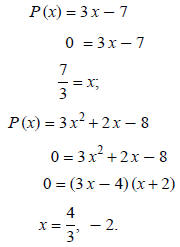
 is a root and a zero
for P (x) = 3 x − 7.
is a root and a zero
for P (x) = 3 x − 7.
 and −2 are roots and zeros for P (x) = 3 x2
+ 2 x − 8.
and −2 are roots and zeros for P (x) = 3 x2
+ 2 x − 8.
Other values of the function can be found by placing desired values into the
function.
Example 1: Find P (−3) given P (x) = 2 x2 − 4 x + 6:

Example 2: Let's try problem 18b on page 56 of your text.
Find k (1 + i) given k(x) = x2 (x2 + 16)
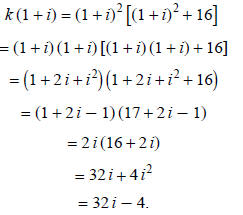
Synthetic substitution is another method that can be used
to find values of functions. I will use
synthetic substitution to determine the value of f (−5) when f (x) = 2 x3 − 3 x2
+ 4 x + 5.
List all of the coefficients. Drop the leading coefficient down, multiply 2 by
−5, and place in the
box:

Add −3 and −10. Multiply −13 by −5 and place in the box:

Add 4 and 65. Multiply 69 by −5 and place in the box:

Add 5 and −345:

The result is −340, so f (−5) = − 340.
Let's check it out:
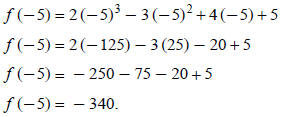
For this problem, synthetic substitution would have been
the quicker method. The synthetic
substitution can be done in one step as follows

Example 3: Use synthetic substitution to find P (−2) when
P (x) = x5 − 1.
There are several missing terms in x5 − 1. The complete polynomial equation is
x5 + 0 x4 + 0 x3 + 0 x2 + 0 x − 1. All terms must be used in synthetic
substitution:

In this problem P (−2) = (−2)5 − 1, but −32 − 1 = − 33 is
quicker. Which method would be
quicker for P (−1) = x15 − 2? Think of all the missing terms! This would be
quicker using
substitution. Use the method best suited for the situation.
Example 4: Let's try problem 24 on page 57 of your text.
If 2i is a zero, then f (2i) = 0:
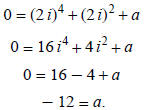
Example 5: Let's try problem 30b on page 57 of your text.
Given g (x) = 3 − 8 x, find g (x + 2) − g (x):
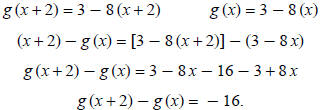
Study Exercises
Complete odd-numbered problems 1–27 in the Written Exercises section on pages
56–57 of your
text. Then check your answers in the back of the text.
Section 2-2: Synthetic Division: The Remainder and Factor Theorems, pp. 58–61
Synthetic substitution is versatile. Used not only to find the value of a
function, it can also be used to
find the quotient and remainder in a polynomial division problem. When it is
used in this manner, it
is referred to as synthetic division. I will work through a polynomial division
problem and compare
the results to those in a corresponding synthetic division.
 |
 |
Multiply
 |
|
| subtract |  |
||
| subtract |  |
Multiply
 |
|
Multiply
 |
|||
| subtract | |||
| remind | |||
Since I divided by x − 2, I will use 2 in my synthetic
division. If I had divided by x + 3, I would
have used −3 in my synthetic division:

The remainder is 4 and 3 x2 + 1 x + 3 is the quotient.
If the binomial x − 2 would have been a factor of 3 x3 − 5 x2 + x − 2, the
remainder would have
been zero. So if my only desire is to determine if x − 2 is a factor of 3 x3 − 5
x2 + x − 2, I don't need
to divide it out. I could use synthetic division and just look at the remainder.
Or, I could use
substitution. In this case, I would find P(2) given P(x) = 3 x3 − 5 x2 + x −
2:
P(2) = 3 (2)3 − 5 (2)2 + 2 − 2.
P(2) = 4 is the same as the remainder.
This demonstrates the REMAINDER THEOREM.
| REMAINDER THEOREM When a polynomial P (x) is divided by x − a, the remainder is P (a) |
So, depending on the problem, I could choose synthetic
division or substitution to determine if x − a
is a factor of P(x). If I wish to divide a polynomial by a polynomial of a
degree higher than 1, I need
to use long division.


